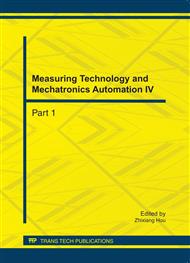[1]
S. Boccaletti, V. Latora, Y. Moreno, et al: Physics Reports Vol. 424 (2006), p.175.
Google Scholar
[2]
R. Cohen, S. Havlin: Complex Networks: Structure, Robustness and Function (Cambridge University Press, New York 2010).
Google Scholar
[3]
L. Guo, X.M. Xu: Complex networks (Shanghai Scientific & Technological Education Publishing House, Shanghai 2006).
Google Scholar
[4]
A. Arenas, A.D. Guilera, J. Kurths, et al: Physics Reports Vol. 469 (2008), p.93.
Google Scholar
[5]
G.R. Chen, X.F. Wang, X. Li, et al, in: Recent Advances in Nonlinear Dynamics and Synchronization, edtied by K. Kyamakya, Springer-Verlag, Berlin Heidelberg (2009).
Google Scholar
[6]
L.M. Pecora, T.L. Carroll: Physical Review Letters Vol. 80 (1998), p.2109.
Google Scholar
[7]
T.E. Gorochowski, M.D. Bernardo, C.S. Grierson: Physical Review E Vol. 81 (2010), 056212.
Google Scholar
[8]
T. Pereira: Physical Review E Vol. 82 (2010), 036201.
Google Scholar
[9]
A.H. Hu, Z.Y. Xi, L.X. Guo: Chaos Vol. 20 (2010), 013112.
Google Scholar
[10]
Z.K. Li, Z.S. Duan, G.R. Chen, et al: IEEE Transactions on Circuits and Systems—I Vol. 57 (2010), p.213.
Google Scholar
[11]
Y.W. Wang, H.O. Wang, J.W. Xiao, et al: Automatica Vol. 46 (2010), p.197.
Google Scholar
[12]
Y.Y. Liu, J.J. Slotine, A.L. Barabasi: Nature Vol. 473 (2011), p.167.
Google Scholar
[13]
X.J. Wu, H.T. Lu: Physics Letters A Vol. 375 (2011), p.1559.
Google Scholar
[14]
I. Necoar, V. Nedelcu, I. Dumitrache: Journal of Process Control Vol. 21 (2011), p.756.
Google Scholar
[15]
M. Brede: European Physical Journal B Vol. 74 (2010), p.217.
Google Scholar
[16]
C. Yin, S.M. Zhong, W.F. Chen: Communications in Nonlinear Science and Numerical Simulation Vol. 16 (2011), p.1632.
Google Scholar
[17]
J.H. Lu, X.H. Yu, G.R. Chen, et al: IEEE Transactions on Circuits and Systems—I Vol. 51 (2004), p.787.
Google Scholar
[18]
D.D. Siljak, A.I. Zecevic: Annual Reviews in Control Vol. 29 (2005), p.169.
Google Scholar
[19]
Y.L. Xiao, C. Zhang: Electrical Automation Vol. 1(2000), p.20.
Google Scholar
[20]
J. Kennedy, R. Eberhart: Proceedings of IEEE International Conference on Neural Networks, Perth Australia, (1995), p. (1942).
Google Scholar
[21]
G. Chen, T. Ueta: Int. J. Bifurcation Chaos Vol. 9 (1999), p.1465.
Google Scholar
[22]
K.J. Astrom, T. Hagglund: PID Controllers: Theory, Design and Tuning (Instrument Society of America, New York 1995).
Google Scholar
[23]
A.O. Dwyer: Handbook of PI and PID Controller tuning rules (Imperial College Press, London 2003).
Google Scholar
[24]
A.L. Barabasi, R. Albert: Science Vol. 286 (1999), p.509.
Google Scholar


